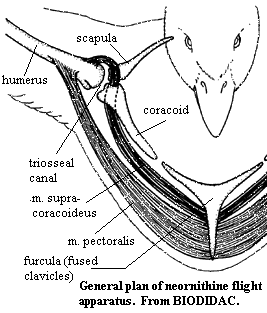ezeedad
109 posts
Dec 01, 2007
2:24 PM

|
I learned a while back, that the supracoracoideus muscle is the main muscle in birds that is responsible for the upstroke of the wings.
This muscle is located in the breast. In most birds it is about 10% the size of the Pectoralis, which gives power to the downstroke. This muscle is also called chicken tenders. It is seperated from the pectoralis by a membrane.
I mention this because for a long time I thought that only the back muscles were responsible for the upstroke and were also mainly responsible for the spasm, or irregular stroke, that causes roll.
Paul G

flight muscles (pectoralis & supracoracoideus) are very large & located near the center of gravity:
pectoralis or downstroke muscle - originates on the keel and inserts on the underside of the humerus
supracoracoideus or upstroke muscle - originates on the keel and inserts on the upper side of the humerus
Last Edited by on Dec 01, 2007 2:55 PM
|
PR_rollers
159 posts
Dec 01, 2007
2:38 PM

|
good post Paal..we learn something new everyday...
----------
Ralph....
|
ezeedad
110 posts
Dec 01, 2007
2:41 PM

|
The powerful flight of the hummingbird comes from its pectoral and supracoriodus muscles. The pectoral muscles lower the wings. The hummingbird has the largest pectoral muscle relative to its body size in the animal kingdom (Dial 1990). The supracoriodus muscle is responsible for the raising of the wing. It is sometimes called the elevator muscle. The hummingbirds supracoriodus weighs from a third to a half as much as the pectoralis ("The Birds", 1988). In other birds it only weighs a tenth to a twentieth ("The Birds", 1988). This is because the hummingbird has to raise it’s wing with almost as much force as it lowers it in order to hover. The tendon of the supracoracoideus muscle is connected to the head of the humerus in a way that allows the humerus to rotate (VanTyne, 1971). In other birds the tendon of the supracoracoideus is connected in a way to elevate the humerus
|
CSRA
623 posts
Dec 01, 2007
4:18 PM

|
Nice post thanks for sharing
|
Santandercol
1719 posts
Dec 01, 2007
4:30 PM

|
That's interesting.The hummingbird flys high during migration too,eh.And all the way to Central America.
----------
Kel.
Rum-30 Lofts
|
3757
355 posts
Dec 01, 2007
4:32 PM

|
Paul - These are precisely the type of topics that will help individuals understand the physiology of their birds and a new awareness of topics that has not been discussed much. Great post!
Dr. LD
|
ezeedad
113 posts
Dec 01, 2007
4:36 PM

|
Steve,
Glad to see that you saw this.
Kel, Hummingbirds are very awesome..
LaRon, Thanks. I'm trying to contribute while I have time..
|
Oldfart
270 posts
Dec 01, 2007
5:23 PM

|
I'm impressed, thanks for sharing.
Thom
|
gotspin7
704 posts
Dec 01, 2007
6:10 PM

|
Paul, always full of info! Thanks for sharing!
----------
Sal Ortiz
|
Santandercol
1723 posts
Dec 01, 2007
8:25 PM

|
Paul,
I feed them by growing a ton of flowers in the yard.
----------
Kel.
Rum-30 Lofts
|
GREED FOR SPEED LOFT
298 posts
Dec 01, 2007
9:41 PM

|
Paul great information.. You can never get or have enough knowledge. THANKS.
R-LUNA
|
ezeedad
115 posts
Dec 01, 2007
9:47 PM

|
Maybe I should have edited out the reference to the hummingbird. I just wanted to try to make it clearer that this muscle is responsible for the raising of a birds wings. That muscle seems to be proportionally larger in birds that have to burst suddenly upwards like quails and grouse.
This may be something to consider with rollers.
|